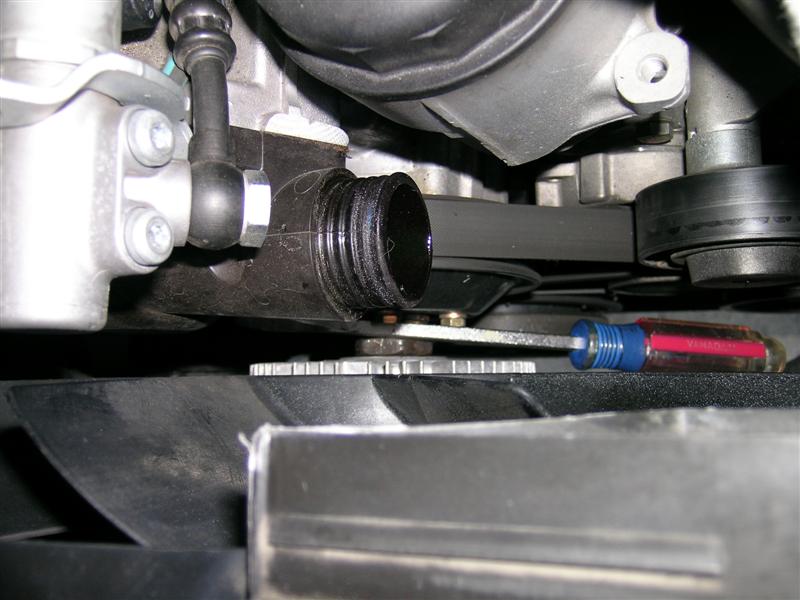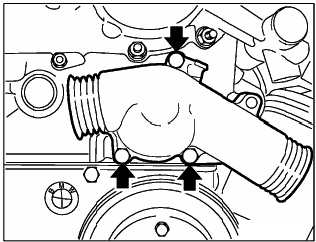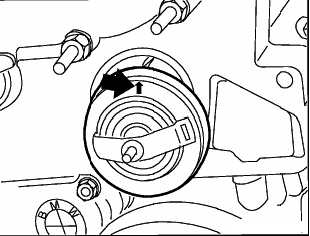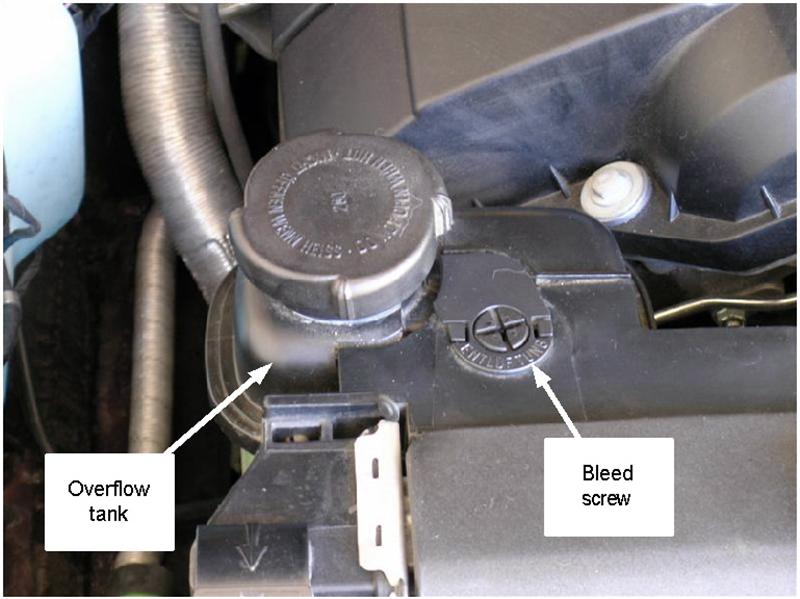BMW E36 Thermostat Removal And Coolant Flush
Disclaimer: The cooling system is critical to the proper operation of your car. Failure to properly install all of the components of the cooling system could result in a damaged engine or you being stranded. Caution must be taken to properly secure your car when working underneath it to avoid injury (or death).Safety notice: When working with engine coolant, precautions must be taken. Coolant is a dangerous chemical to both people and animals. Animals are known to like the taste of coolant due to it's sweet smell. All efforts must be taken to ensure that coolant does end up in any location which may be consumed by animals and should always be disposed of properly. Never remove the radiator coolant cap while the engine is hot. Severe burns can result from hot coolant spraying out of the radiator cap or from the drain plugs.
This job was being done on a '98 328iA Cabrio. The reason for doing this work stemmed from the fact that the car was not fully warming up in the winter time. I suspected a faulty thermostat that was not closing properly and decided to replace it. At the same time I chose to replace the stock plastic thermostat housing with an aluminium one based on reports I had read of premature failure of the plastic part.
Since the coolant had to be drained (partially) to replace the thermostat, I further decided to flush the entire cooling system and replace all of the coolant with new.

Parts needed:
A) 2 jugs of BMW coolant
B) 2 - 4 litre jugs of distilled water
C) New thermostat (with new o-ring)
D) Funnel
E) New aluminium thermostat housing (with gaskets)
Not shown:
* New washer for engine drain plug
* 32mm wrench
* various size sockets and wrenches
* torque wrench (should support 2-25 Nm range)
* 1-2 large buckets (that will fit under your car)
* floor jack
* jack stands
* wheel chocks
* gloves
* rags
Section 1 - Coolant Draining and Thermostat Removal
Step 1: Perform this work with the engine cold or at least let it cool down for several hours.
Step 2: Since the coolant that is put into your car is diluted 50/50 with water, it is easier to pre-mix it before you start pouring it in. To easily do this, get one or two empty 4 litre water jugs and using a measuring cup, measure out the 2 litre and 4 litre marks and put these lines on the side of the jugs.

Step 3: Pour 2 litres of distilled water into each of the containers. Do not use tap water as this can cause problems inside your engine. For the couple of bucks it will cost you to get distilled water (from your grocery store), why would you not put the correct stuff in your engine?
Step 4: Fill the remainder of each jug with 2 litres of BMW coolant. In most cases this should give you enough coolant mix to refill your car but if you end up needing more you can refill one of the jugs again later.
Step 5: Block both rear wheels securely.
Step 6: Jack up the front of the car and put both sides on jack stands.
Step 7: Inside the car, turn the ignition to the ON position (without starting the car) then turn the heater setting to the highest temperature.
Step 8: Turn the ignition off.
Step 9: Slide under the front of the car and place a bucket nearby. Unscrew the radiator drain plug and position the bucket to contain the coolant which comes out. If done correctly, no coolant should spill onto the ground.

Step 10: After the radiator had fully drained, set the radiator drain plug aside then move the bucket further towards the centre of the car near the oil pan to catch the output from the engine block coolant drain plug.
Step 11: The engine drain plug is very difficult to see and can only be accessed from underneath the car. It is located on the passenger side of the engine in between the exhaust headers. On the '98 328 that I did this work on, the drain plug was located right next to one of the oxygen sensors. Feel around with your hand for the only item on that side of the engine that looks like a drain bolt (similar to the oil drain plug).
Step 12: On this car, the engine coolant drain plug required a 19mm wrench. Because it was right next to one of the oxygen sensors, it was difficult to remove and took some time to get the wrench in the right spot to loosen the bolt. As soon as the plug is loosened, coolant will start to drip down so have the bucket ready.
Note: Do not remove the engine drain plug all the way out. If you keep the drain plug partially in the drain hole, the coolant will come out in a more controller manner. This will allow you to catch all (or most) of it in your bucket as opposed to it falling all over the floor. As needed, use rags to contain any coolant which may be dripping onto the ground.
Step 13: Let the remainder of the coolant drain from the rear drain plug. This will probably take up to 30 minutes to complete with the plug still partially in.
Step 14: Remove the alternator cooling duct. This duct is not secured with any fasteners so it just removes by pushing it out.
Step 15: Remove the 6 screws that attach the shroud.

Step 16: Loosen the hose clamps on the two hoses attached to the thermostat housing then slide the hoses off. Bend the hoses out of the way.

Step 17: Using the 32mm wrench, loosen the engine fan retaining nut. As the retaining nut is threaded in reverse, you must move the wrench clockwise (to the right) to loosen the nut.

Note: If the nut doesn't loosen, try striking the end of the wrench with a rubber mallet. If it still doesn't budge, you may have to try and get a screwdriver in between the pulley bolts to hold it in place.

Step 18: Once the fan retaining nut is loose, unscrew it by hand while holding onto the fan (so it doesn't drop when the nut is unscrewed).
Step 19: Carefully lift the fan out of the car (being careful not to damage any of the plastic blades or the radiator on the way out).
Step 20: Once out of the car, clean the front of the fan of any dirt using a brush. Put the fan aside but store it in an upright position (the same as it normally is in your car).
Step 21: Remove the two bolts which secure the engine lift bracket then remove the bracket.

Step 22: Remove the remaining 3 bolts to the thermostat housing then lift out the housing.

Step 23: Once the thermostat housing is removed, the thermostat will be visible. There will be a small arrow stamped on the thermostat. Observe the orientation of the arrow on the thermostat as the new one will be installed in the same way.

Step 24: Remove the thermostat.
Step 25: Clean the area around where the thermostat was mounted.
Section 2 - Flushing the Engine
While the engine coolant has been removed, there still may be sediment in the cooling system which can be more thoroughly removed by "flushing" the system. While the thermostat is removed, it is an ideal time to flush the cooling system as it can be done without having to warm up the car to full operating temperature.
Step 1: Reinstall the drain plugs on the radiator and engine block hand tight.
Step 2: Install the new thermostat housing without the thermostat (or the original one if you are not installing a new one). Tighten the bolts hand tight.
Step 3: Attach the two hoses to the thermostat housing without either hose clamp attached.
Step 4: Place some rags around the mouth of the radiator overflow tank. This will hopefully prevent coolant from splashing onto your paint and staining it.

Step 5: Using a garden hose or large watering can, fill the radiator with as much water as it will hold.
Step 6: Start the engine.
Step 7: Monitor the level of water in the radiator and add as needed until no more water can be added.
Step 8: Run the car for about 5 minutes.
Note: During the flushing process, occasionally check the coolant temperature from inside the car. Turn the engine off if the temperature rises beyond the normal limit.
Step 9: Let the car cool down for about 15-30 minutes then drain the water out of the radiator and engine block as in section 1.
Caution: the rear engine drain plug is close to the exhaust pipes which can remain hot for quite a long time after the engine is turned off. If necessary, use a glove to remove the rear drain plug to avoid getting burned.
Step 10: Remove the hoses from the thermostat housing then remove the thermostat housing from the engine again.
Step 11: There may be some residual gasket material on the thermostat housing or the engine block where the housing mounts to the engine. Using a plastic scraper or other non-metal tool, ensure that both surfaces are clean and all traces of foreign matter are removed. If these surfaces do not mate properly, you may end up with a coolant leak later on.
Step 12: Put a new metal washer on the rear drain plug then tighten. While this plug is supposed to be torqued to 25Nm, I found it impossible to get a torque wrench in there and had to tighten it by hand with a wrench.
Step 13: Reinstall the radiator drain plug and torque to 2-3 Nm. As this drain plug is made of plastic, it is very easy to strip when installing if not using a torque wrench.
Step 14: Install the new thermostat and the new O-ring supplied with it. Ensure that you orient the new thermostat the same way as the one that you removed and that it is facing the right direction front to back.

Step 15: Install the gaskets onto the thermostat housing and place the housing over top of the thermostat on the engine. Using the three smaller bolts, hand tighten to hold it in place.
Note: When placing the thermostat housing up to the engine, it is important that all gaskets and the thermostat do not fall out of place before the bolts get tightened. If this happens you will have coolant leaks.
Step 16: Put the engine lift bracket back in place then tighten the bolts by hand.
Step 17: Tighten the bolts to the engine lift bracket to 22Nm.
Step 18: Tighten the remaining three thermostat housing bolts to 10Nm.
Step 19: Reinstall the lower hose to the thermostat housing and tighten clamp. Ensure that the hose is all the way onto the hose fitting and it not kinked in any way.
Step 20: Carefully move the fan back into place and thread the mounting bolt onto the pulley. The manual says to torque to 40Nm without a special BMW tool or 30Nm with the tool. I hand tightened this with the 32mm wrench to what I felt was appropriate.
Step 21: Reinstall the upper hose to the thermostat housing and tighten clamp.
Step 22: Reinstall the alternator cooling duct then reinstall the 5 mounting screws for the shroud.
Step 23: Remove the jack stands and lower the car back to its normal position.
Section 3 - Refilling the Engine Coolant
Step 1: Using a funnel, start slowly pouring the coolant mix into the overflow tank.
Note: Take your time when pouring coolant back into your car. The car will only accept new coolant at a certain rate and will easily overflow. Do everything you can to avoid spilling coolant.
Step 2: Fill the new coolant up to the "Cold" mark on the passenger side of the overflow tank. You will find that if you wait a few moments when it gets to this mark the fluid level will go down. Keep adding more fluid until it stops going down and stays at the Cold mark.
Note: Having a light source to illuminate the inside of the funnel helps to see where the fluid level.

Step 3: Loosen the radiator bleed screw.
Step 4: Turn the ignition to the On position but do not start the car.
Step 5: Continue to slowly add coolant - adding more after the level has dropped.
Step 6: Eventually coolant will start to bubble out of the bleed screw. When the bubbling has stopped and only fluid comes out of the bleed screw hole, tighten the bleed screw while continuing to pour.
Step 7: Replace the radiator cap.
Step 8: Start the car and let it heat to the normal operating temperature.
Step 9: Check for any obvious coolant leaks.
Step 10: Using a hose, quickly spray the inside of the engine and underneath the car to rinse away any coolant remnants.
Step 11: Clean up your tools.
Step 12: Dispose of the old coolant according to the laws in your area. Do not pour coolant down the drain or into the ground.
Follow Up: When the car has cooled down for several hours or the next day, check the coolant level in the expansion tank. If it is below the Cold level, add more coolant mix to bring it to this level. For the next day or so, look underneath your car and also inside the engine compartment when it has been parked for several hours to see if there are any leaks. Sometimes a coolant leak may take several days to be noticeable.
ไม่มีความคิดเห็น:
แสดงความคิดเห็น